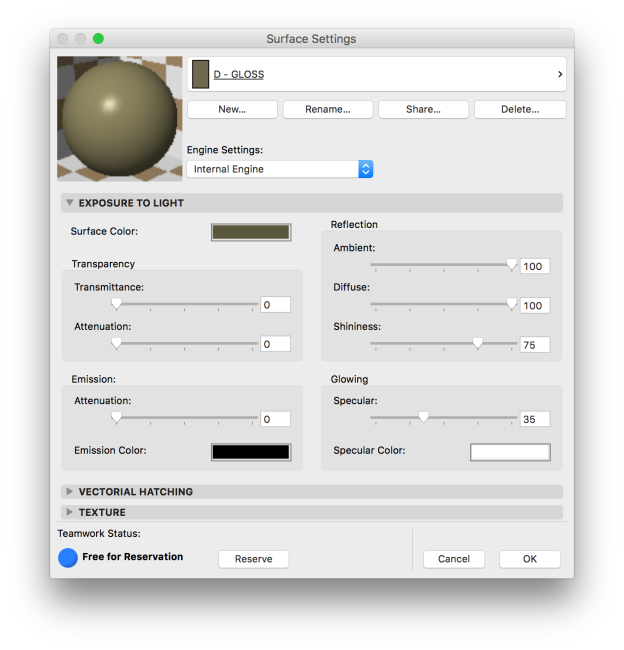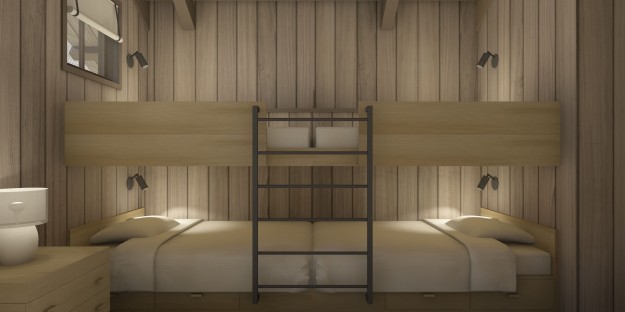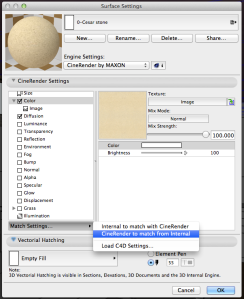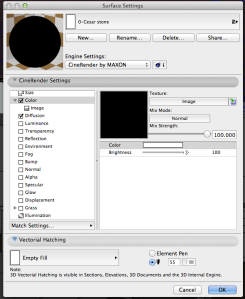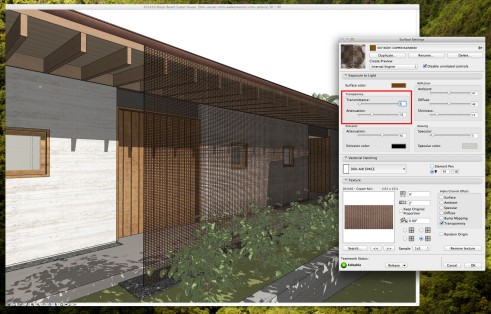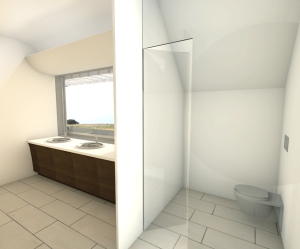There are quite a few resources for ready made CineRender compatible surfaces. We have 2 catalogues of surfaces in our library folders. If you want to develop a new surface from scratch, you need to duplicate an existing surface, or create a new surface from the Library Catalogs and then edit it. In this exercise, we will be duplicating our basic massing surface to create a new stone surface.

Fig 1.0 Creating New Surfaces
Once the surface has been created by duplicating a previous surface it can be manipulated and edited to include the correct image and render out properly in CineRender, ARCHICAD’s 3D window, and BIMx.

Fig 2.0 New “Duplicated” Surface
The first thing to do after creating the surface is to apply a Surface Texture. This can be an image from our Arroway texture catalog (FS01 > WW AC Library > 01 Arroway Textures), or from a custom photoshopped image. For this example, I am using an Arroway image and its corresponding bump map image (for the CineRender settings).

Stone Surface

Bump Map
After the Surface Texture is applied, you can start to play with the scale, light settings, and transparency. For solid surfaces, transparency should always be set to 0. Emission Attenuation is not completely relevant, unless you are applying an Emission Color to the surface. This can be a very helpful effect if you want to alter the color of a surface, just be aware that the surface is actually emitting a color with this setting. Below are some examples of various Emission Color Settings. Note that, in order to get the surface to match the original image, the Emission Color should be black, or as dark as possible.
-

-
Emission Color – Black
-

-
Emission Color – Gray
-

-
Emission Color – White
-

-
Emission Color – Orange
-

-
Orange + Attenuation
For this Surface, we are simply going to leave the Emission Color Black with no Attenuation. With a black Emission, you will get a solid black surface until you apply Reflection and Glowing Settings. After years of trial and error, I have found that the ideal Reflection Settings for semi-matte surfaces are:
- Ambient = 75-85
- Diffuse = 75-87
- Shininess = 8-15
- Specular Glowing = 0-12
Lastly, if you have a bump map image for the surface, make sure you check Bump Mapping under Alpha Channel Effects. This will define a bump map option in the CineRender settings when matched to the Internal Engine. A bump map image is easy to generate in photoshop with the threshold filter. Keep in mind that the lightest parts of the map are the closest, or the “bumps”; and the darker portions are the recesses.
From here, lets just switch over to the CineRender settings and match. Simply click Match Settings… and choose Update CineRender Settings (from Internal).

Fig 5.1 CineRender Settings

Fig 5.2 Match CineRender from Internal Settings
From here, you can go to the Bump map tab, and change the image to the correct black and white bump map from the Arroway Catalogue, or one that you have created for a custom surface. The Bump Map and the main image file need to align perfectly and be saved at the same size and resolution.
You can check that they are both being aligned and resized properly in the Size tab of the CineRender Settings. You can click on the more Info “…” to the right of the line that reads Use Image Proportion:

Fig 6.0 Surface Sizes used in CineRender Settings
You can quickly adjust and test the intensity of the bump map by doing quick “outdoor daylight” renderings of a single element or surface. With a little luck and lots of trial and error, you can come up with a surface that maps out correctly and looks good in all views and formats it will be used in!

Fig 7.0 Rendered Stone Surface


